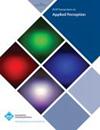变形灯:一种使静态物体在感知上动态的投影技术
IF 1.9
4区 计算机科学
Q3 COMPUTER SCIENCE, SOFTWARE ENGINEERING
引用次数: 44
摘要
光投影是一种强大的技术,可以用来编辑现实世界中物体的外观。基于光传输的逐像素修改,以前的技术已经成功地修改了静态表面特性,如表面颜色、动态范围、光泽度和阴影。在这里,我们提出了一种替代光投影技术,该技术将各种虚幻但现实的扭曲添加到广泛的静态2D和3D投影目标中。我们的技术的关键思想,被称为(变形灯),是只投射动态亮度信息,这有效地激活了视觉系统中的运动(和形状)处理,同时保留了原始物体的颜色和纹理。尽管投影的动态亮度信息在空间上与目标物体的颜色和纹理不一致,但观察者的大脑会自动将这些感官信号组合起来,以纠正视觉属性之间的不一致。我们进行了一项心理物理实验来研究不一致纠正的特征,并发现纠正严重依赖于不一致的视网膜大小。另一个实验表明,我们的技术所产生的图像变形的感知幅度被低估了。这一结果排除了我们的技术所获得的效果仅仅是由于光投射在物体外观上的物理变化而产生的可能性。最后,我们讨论了我们的技术如何使观察者感知到各种静态物体的生动和自然的运动,变形或振荡,包括绘制的图片,打印的照片,具有3D阴影的雕塑,以及具有自然纹理的物体,包括人体。本文章由计算机程序翻译,如有差异,请以英文原文为准。
Deformation Lamps: A Projection Technique to Make Static Objects Perceptually Dynamic
Light projection is a powerful technique that can be used to edit the appearance of objects in the real world. Based on pixel-wise modification of light transport, previous techniques have successfully modified static surface properties such as surface color, dynamic range, gloss, and shading. Here, we propose an alternative light projection technique that adds a variety of illusory yet realistic distortions to a wide range of static 2D and 3D projection targets. The key idea of our technique, referred to as (Deformation Lamps), is to project only dynamic luminance information, which effectively activates the motion (and shape) processing in the visual system while preserving the color and texture of the original object. Although the projected dynamic luminance information is spatially inconsistent with the color and texture of the target object, the observer's brain automatically combines these sensory signals in such a way as to correct the inconsistency across visual attributes. We conducted a psychophysical experiment to investigate the characteristics of the inconsistency correction and found that the correction was critically dependent on the retinal magnitude of the inconsistency. Another experiment showed that the perceived magnitude of image deformation produced by our techniques was underestimated. The results ruled out the possibility that the effect obtained by our technique stemmed simply from the physical change in an object's appearance by light projection. Finally, we discuss how our techniques can make the observers perceive a vivid and natural movement, deformation, or oscillation of a variety of static objects, including drawn pictures, printed photographs, sculptures with 3D shading, and objects with natural textures including human bodies.
求助全文
通过发布文献求助,成功后即可免费获取论文全文。
去求助
来源期刊

ACM Transactions on Applied Perception
工程技术-计算机:软件工程
CiteScore
3.70
自引率
0.00%
发文量
22
审稿时长
12 months
期刊介绍:
ACM Transactions on Applied Perception (TAP) aims to strengthen the synergy between computer science and psychology/perception by publishing top quality papers that help to unify research in these fields.
The journal publishes inter-disciplinary research of significant and lasting value in any topic area that spans both Computer Science and Perceptual Psychology. All papers must incorporate both perceptual and computer science components.
 求助内容:
求助内容: 应助结果提醒方式:
应助结果提醒方式:


